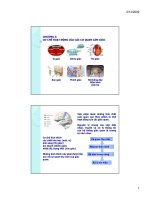food characteristics
Bạn đang xem bản rút gọn của tài liệu. Xem và tải ngay bản đầy đủ của tài liệu tại đây (693.99 KB, 41 trang )
Handout MK. Pengawasan Mutu
2011/2012
FOOD CHARACTERISTICS
Physical
Chemical
Food
Characteristics
Biological &
Microbiological
Sensory
Physical
Shape
Color
Food
Characteristics
Size
Surface condition
Texture
Freshness
Defects
Total solids, etc
Appearance
Chemical
Nutritional value
Food
Characteristics
Moisture content
Functional value
pH
Food additives
Chem contaminants
Etc
Biological &
Microbiological
Total bacteria
Food
Characteristics
Total coliform bacteria
Total mold
Free from pathogenic mos
Etc
Sensory
Flavor
Food
Characteristics
Aroma
Taste
Texture
Etc
Physical Attributes
• Physical attributes of food are related with
the appearance of food products, including:
– Color
Appearance
– Shape
The first
– Size
impressio
– Texture
n
– Etc.
COLOR
Color is the one of the most important image
features because it contains the basic human
vision.
Color significantly affects the consumer
perception of quality.
If the color is unacceptable, the other two
major quality factors,
flavor and texture, are not
likely to be judged at all.
COLOR
Color may be defined as the impact of the
wavelengths of light in the visual spectrum
from 390-760 nm on the human retina.
The retinal cells may be sensitive to black and
white only or to red, green and blue (RGB)
wavelengths of light.
The correct interpretation by the brain in terms
of color depends on the adequacy of signals.
COLOR
• Light is the basic stimulus of colors, it is important to
consider the electromagnetic spectrum.
• Visible light forms only a small part of the
electromagnetic spectrum, with a spectral range from
approximately 390 nm (violet) to 750 nm (red).
• The sensitivity of the eye varies even within this narrow
visible range. Under conditions of moderate-to-strong
illumination, the eye is most sensitive to yellow-green
light of about 550 nm.
Factors affecting color
Chemical composition
The appearance of a product as judged by its
color often be used to determine the pigment
content of a product, which in turn is often an
index of quality.
Color measurement can be used to evaluate
pigment content (carotenoid, anthocyanin,
chlorophyl, etc.)
Colorimetry and chromatography can be used to
measure the pigment content of food product.
Factors affecting color
Effect of lighting
The type of light falling on a object will affect the
perception of color.
For example, when green light is directed onto a
white sheet of paper, the paper will appear to be
green.
But within fairly narrow ranges, the human brain
will compensate for small shifts in the color of the
lighting because the brain anticipates what the
color should be.
Factors affecting color
In food products, it is possible to make products
look better or worse depending on the lighting.
Lighting in supermarkets is designed for the ability
to make product more favorable. But no single
lighting arrangement is optimum for every food
product. Example :
Cranberry juice under normal fluorescent tube light
with a high blue component will appear almost
black, while under warm fluorescent lighting with a
higher yellow-red component will appear much
redder.
Factors affecting color
Lighting to improve color appearance had been
studied in detail in the red meat industry.
It is possible to make cuts of red meat look much
redder by illuminating them with a pink light or by
placing a reflector painted red near the display
case.
However, sometimes this method is considered
as a fraud because the consumer sees the actual
color when product is unpacked at home.
Interaction of color with other senses
Color seems to have significant effect on the
perception of sweetness, but only have little effect
on the perception of saltiness.
Many studies have shown that solutions colored
dark red will perceived to be sweeter than others of
the same sucrose concentration in lighter colors or
distilled water.
Color scales
• There are three characteristics of light by which a color
may be specified: hue, saturation, and brightness.
• Hue is an attribute associated with the dominant
wavelength in a mixture of light waves, i.e., it represents
the dominant color as perceived by an observer.
• Saturation refers to relative purity or the amount of
white light mixed with a hue.
• Brightness is a subjective term, which embodies the
chromatic notion of intensity.
• Hue and saturation taken together are called
chromaticity.
• Therefore, a color may be characterized by brightness
and chromaticity.
Color scales-CIE System
• The basic colors however are only three: red, green
and blue, and other colors are derived by mixing these
three.
• The Commission Internationale de l’Eclairage (CIE)
defined a system of describing the color of an object
based on three primary stimuli: red (700 nm), green
(546.1 nm), and blue (435.8 nm).
• The amounts of red, green, and blue needed to form
any given color are called the’ ‘tristimulus” values, X,
Y, and Z, respectively.
• A plot that represents all colours in x (red)-y (green)
coordinates is known as a chromaticity diagram
Color scales-CIE System
Color scales-CIE System
• Sometimes, tristimulus systems of representation of
colors are not easily understood by the users in
terms of object color. Other color scales therefore
were developed to relate better to how we perceive
color, simplify understanding.
• A 3-dimensional rectangular L, a, b, color space was
evolved, in which at L (lightness) axis – 0 is black
and 100 is white, a (red-green) axis – positive
values are red; negative values are green and zero
is neutral, and b (blue-yellow) – positive values are
yellow; negative values are blue and zero is neutral.
Color scales-CIE System
• There are two popular L, a, b color scales in use
today – Hunter L, a, b, and CIE L∗, a∗, b∗.
• They are similar in organization, but will have
different numerical values.
• Hunter L, a, b and CIE L∗, a∗, b∗ scales are
both mathematically derived from X, Y, Z values.
• Hunter scale is over expanded in blue region of
color space, while CIE scale is over expanded in
yellow region. The current recommendation of
CIE is to use L∗, a∗, b∗.
Color scales-CIE System
Size
Size is very important feature since it can
determine the loss of products during processing
and the final product yields.
Size can be measured in three dimensions such as
volume in the real world. However, it is usually
reduced to one or two dimensional measurements.
Size features include weight, volume, diameter,
area, surface area, perimeter, length, skeleton
length and width.









